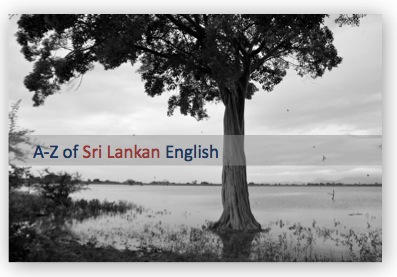I normally try to stay on the right side of the descriptive-prescriptive divide, but today I’ve got my prescriptive hat on. I deplore the habit of some writers, editors and publishers of employing French and German accents when rendering Sinhala and Tamil words in English. You might read about more important issues on Groundviews today, but this is my personal bugbear.
The most common example is kadé with an acute accent, like café – cute, because a kade is sort of like a café I suppose, apart from the croissants and cappuccino. But unfortunately the é vowel in French is a different sound from the e in kade, so it doesn’t help. Why not just spell it kade?
I have come across the acute accent being appropriated with the same function in words such as amudé, andé, dané, kondé, kalé, pin katé, haminé, hiramané, karadaré, and even twice in éllé… Ané deviyané! The late Nihal de Silva used the German umlaut to represent the Sinhala vowel æ as in gärandiya, nända, dagäba, perahära, wäwa, and unaccountably in the English word cädjan, and of course in the title of his novel The Ginirälla Conspiracy. He also favoured the diacritic ā to represent the long vowel in māra tree and karāwa. But these conventions are used inconsistently in his books, suggesting that he himself was unconvinced (and that his editors didn’t notice?). And this leads to oddities such as Rä kadè (sic) and Nänā.
There are three reasons for my campaign against the use of these accents and diacritics:
- There is no agreement on how they should be used. Different writers, editors and publishers use them differently – and often inconsistently within the same text.
- They don’t help. There’s no reason why the sounds they represent should correspond with the vowels of Sinhala and Tamil.
- French accents only exist in English in loanwords from French such as café, cliché, passé, pâté; attaché, resumé, entrée, fiancée; élite, château, façade, naïve; déjà vu, ménage à trois, raison d’être, tête à tête, … Even in these cases the accents tend to be dropped as the words become established in the English lexicon. The same applies to the German umlaut on words such as Doppelgänger, Führer, gemütlich and Übermensch.
So if you don’t use accents, how do you convey the 14 vowel sounds of Sinhala and Tamil with just the 5 English vowel letters? Well, you can’t. But English itself has at least 12 different vowel sounds represented by those 5 letters. For example, the humble letter a already multi-tasks for the various vowel sounds of apple, about, what, fan, acre, after, all, etc. So it shouldn’t be a problem for the same letter to represent the vowels in amma, ambul and mara.
There is a separate issue here, which is the phonetic transcription of Sinhala and Tamil words and longer passages, where distinguishing all individual sounds is necessary. Unfortunately again, there is no commonly agreed convention for doing this. Personally I use my own font (called Sinfonetic), which includes separate symbols for the 7 short and 7 long vowels of Sinhala/Tamil (using the simple convention of a line across the top to represent a long vowel). An explanation of this system can be found here, and an example of it in action can be found here (in the phonetic transcription of an extract from the children’s book Keerthihan’s Kite).
But the point of this article is not phonetic transcription, but orthography – how Sinhala and Tamil words should be spelt when they are incorporated into English-language texts. And on this, I rest my case that foreign accents and other diacritics have no place.
###
A-Z of Sri Lankan English is“an all-new, occasional alphabetical dip“into the variety of English spoken in Sri Lanka, published exclusively on“Groundviews. The original A-Z of Sri Lankan English was published in the travelsrilanka magazine, and can be found here.

